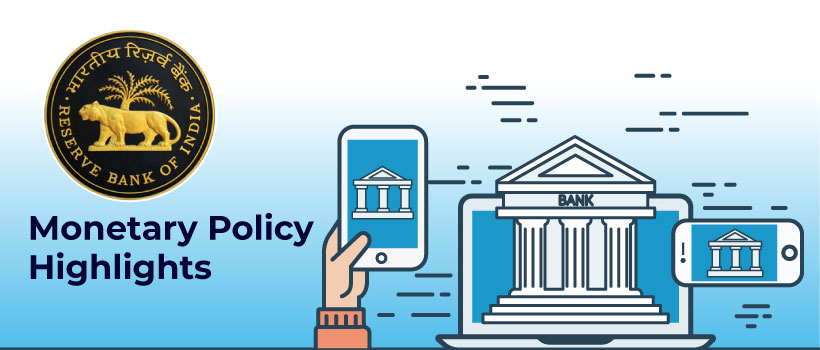List Of Maharatna Companies In India
RBI Monetary Policy Highlights - February 2022

Last Updated: 10th December 2022 - 03:36 pm
When the RBI presented the monetary policy on 10th February, it was amidst an interesting combination of events. On the one hand, domestic inflation was on the way up while on the other hand the US Fed was getting increasingly hawkish. In between, the Union Budget 2022 had announced a sharp spike in the central borrowing target by 25% to Rs.14.95 trillion.
This had resulted in the bond yields shooting up sharply from 6.65% to 6.93%, forcing the government to cancel its bond issue plan on 11-February. It is in this context that the last monetary policy of fiscal FY22 and the first policy of calendar 2022 was presented.
Check - RBI Cancels Bond Auction
If one were to summarize the theme of the monetary, the overbearing theme is still about reviving economic growth. The RBI has pointed out that the GDP growth is still too much dependent on incremental government spending and private consumption is yet to show adequate traction.
That has been the key reason why the RBI has chosen to still maintain a dovish stance despite fairly compelling reasons for a rate hike, or at the very least, a repo rate hike.
Highlights of Monetary Policy – February 2022
1) Status quo has been maintained on Repo Rate at 4%; underlining RBI’s commitment to keep rates low till durable growth was back with private consumption.
2) Contrary to popular expectations, the RBI refrained giving a signal by hiking the reverse repo rates from the current level of 3.35% and could happen outside the policy.
3) As a result, the Bank Rate and the Marginal Standing Facility (MSF) rate, remained pegged at 4.25%, despite the huge divergence between bond yields and repo rates.
4) What is rather surprising is that RBI maintained the “Accommodative” monetary stance, rather than shifting to Neutral, or at least hinting at a likely shift. Only J R Varma objected to a blanket assurance on accommodative stance to the market.
5) In terms of GDP growth estimates, RBI downsized the FY22 estimates by 30 bps to 9.2% in line with the NSO. However, the GDP growth for FY23 has been estimated at 7.8%, slightly subdued on account of a partial lag effect of the Omicron variant.
6) CPI inflation target for FY22 has been maintained at 5.3%, despite crude prices rallying more than 30% since the last policy announcement. However, CPI inflation for FY23 has been pegged at 4.5%; hinting at further easing of inflation due to lower food prices and the neutralization of the base effect.
7) All 6 members of the MPC unanimously voted to hold repo rates at 4% till there were visible signs of recovery in growth. However, only 5 out of the 6 members (barring J R Varma) agreed to maintain the policy stance accommodative for as long as needed.
Additional Reforms Proposed by RBI in the Supplementary Document
In the last few policies, the RBI made a number of key announcements outside the policy statement and as part of regulatory measures. Here are some key announcements.
a) RBI announced that the special Term Liquidity Facility for Emergency Health Services to the tune of Rs.50,000 crore as well as the on-tap liquidity window for contact-intensive sectors be extended for a period of 3 months till 30th June, 2022.
b) The Voluntary retention route (VRR) is a window for FPIs to invest in government debt and corporate debt with lower restrictive covenants. Such VRR limit has now been enhanced from Rs.150,000 crore to Rs.250,000 crore with effect from April 2022.
c) The RBI will issue detailed guidelines for credit default swaps (CDS) in India based on the original draft guidelines laid out by the RBI in Feb 2021 incorporating the subsequent feedback received from concerned stakeholders.
d) The RBI will increase the upper limit of e-RUPI vouchers from the current Rs.10,000 to Rs.100,000 for wider delivery of government services. In addition, the NACH mandate limit under the Trade Receivables Discounting System (TREDS) for MSMEs, stands enhanced from Rs.1 crore to Rs.3 crore to ensure better liquidity support for MSMEs.
In a nutshell, the RBI has still stuck to its growth mandate, although it must be said that the inflation projections appear to have a lot of optimism built in. However, if inflation does not follow the glide path down, the RBI and the government will have a real balancing act between regulating inflation and ensuring its borrowing program goes through.
- Flat ₹20 Brokerage
- Next-gen Trading
- Advance Charting
- Actionable Ideas
Trending on 5paisa
Indian Stock Market Related Articles
Disclaimer: Investment in securities market are subject to market risks, read all the related documents carefully before investing. For detailed disclaimer please Click here.
 5paisa Research Team
5paisa Research Team
 Sachin Gupta
Sachin Gupta




